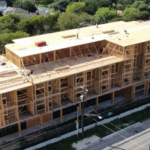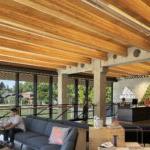专家建议
多层木结构中承重墙螺柱和桁架/托梁的对齐:结构设计考虑
Design and detailing considerations for wall framing when trusses, joists and rafters don’t align with studs in mid-rise light-frame wood buildings.

With the proliferation of mid-rise wood construction across the country, 在工程师和承包商之间争论比较激烈的话题之一是,建筑物的全高度是否需要承重墙柱和地板或屋架/托梁对齐. 从根本上, there are two decisions to make: should bearing wall studs align from floor to floor, 并应楼板/屋顶桁架, 托梁和椽子与墙钉对齐. To make these decisions, one must first answer the following:
- 这个项目有多少个故事或层次?
- 桁架/托梁/椽反力的大小是多少?
- Is there a full-depth rim board and, 如果是这样的话, what is its width? 是实木锯材产品还是工程木制品?
- 楼板桁架顶部有带板吗?
- Are the wall top plates traditional double 2x or something different?
- 螺柱间距是多少?
- 桁架/椽/托梁间距是多少?
从可构造性的角度来看, 允许螺柱和托梁/桁架不对中可能是首选,因为对中需要承包商更高水平的规划和执行. 由于可以在任何给定的水平上优化螺柱间距以适应累积载荷,因此从一个水平到下一个水平的螺柱错位也可以导致更有效的设计.
然而, 地板到地板的螺柱对齐的一个积极的方面是,管道堆栈可以垂直运行为建筑物的高度,而不会干扰螺柱.
螺柱和桁架/托梁不对中
允许从一个水平到下一个的螺柱错位的一种方法是利用全深度的轮辋板. 在这个场景中, the stud above transfers loads to the bottom plate of the wall, 穿过地板护套,进入边缘板. The rim board can then distribute loads to the top plate below, 是什么把载荷转移到错位的螺柱上. As is often the case with wood stud wall design for axial loads, the limiting design criteria can be perpendicular-to-grain loading and capacity of the plates, 而不是轴向和屈曲能力的螺柱. In lieu of a full-depth rim board, a rim girder truss can be evaluated as an option.
Regardless of whether the studs align from one floor to the next, the reactions of the floor/roof trusses/joists must also have a load path to the studs below. 在大多数情况下,桁架/托梁承受下面墙组件的双2x顶板. 最直接的加载路径是始终在每个桁架/托梁的正下方对齐一个螺柱(必要时或多个螺柱). 然而, this may be undesirable from a design standpoint—e.g.当墙钉在16英寸时. o.c. to accommodate minimum spacing for exterior finishes while floor joists are at 24-in. o.c. 最大化地板护套容量. 在这种情况下, 墙板可以在不与托梁/桁架对齐的螺柱之间跨越. If the double plate does not have sufficient capacity to support the reaction of the truss/joist, it is possible to support the truss/joist on the full depth rim board/girder truss first, and then distribute loads to the top plates via the rim board/girder truss. The cost of the fasteners required to achieve this load path should be considered.

用平行弦桁架, a common approach is to use a ribbon board at the top of the floor truss system. 彩带板, 通常是垂直方向的2×4或2×6, 顶部与桁架顶部齐平, 可以设计成从上面的螺柱收集载荷并将其直接转移到连接的楼板桁架的末端吗. 如果楼板桁架系统下方的双层顶板在结构上足以支撑楼板桁架的反力(如有必要,可在下方未对齐的螺柱之间跨越), 那就什么都不需要了. If the double top plate is not structurally adequate to support the truss reactions, 然后另一个带状板可以与桁架平齐底部放置,以重新分配负载到下面的板和螺柱. Alternatively, the studs below the trusses could be made to align with the trusses.
轴承 墙顶板设计过程
如上所述, 传统墙体框架系统中的双2x顶板通常需要传递载荷,因此是墙体设计过程中的关键部件. 在很多情况下, the wall double top plates need to act as structurally-spanning members, resisting concentrated loads (truss/joist reactions) at the middle of a stud bay, 在一个种马湾的尽头, 或者介于两者之间.

照片:丹·多兰
When considering how to address this issue, there are several variables at play, such as:
- If using typical double plate construction with staggered joints, 两个板作为一个复合构件一起工作吗, 如果是这样的话, does adequate nailing between the two need to be provided for 剪切 flow?
- 假设两个板块是相互独立的, 它们之间的负载分布是什么? Does the top plate take as much load as it can and the bottom plate take the rest? 两个板的负荷是否均匀分配?
- 板间载荷传递的理由是什么?(不管传递的大小如何)? 是否假设两个板的挠度/刚度相等? Is direct bearing of the top plate on the bottom plate considered adequate for load transfer? Is load transfer between the two plates different when looking at moment vs. 剪切?
- Should this analysis assume both plates are simple span for one stud bay, should one of the plates be assumed continuous for several adjacent bays, 或者两个板应该是连续的几个海湾?
- 墙体石膏或木结构板护套是否有助于抵抗作用在顶板上的垂直力?
This condition is not specifically addressed in the International Building Code, 国家 Design Specification® (NDS®) for Wood Construction, 或其他规范或参考标准. 进行这种分析也有多种方法, 哪些可以产生显著不同的结果.
最保守的分析是假设两个板块作为一个复合材料共同作用, 3-in.-抗剪和抗弯深构件. 虽然有些工程师 使用 这种 方法, 它可以是不保守的 ,因为木构件的钉接 相对灵活,两个板之间的典型钉接模式由于钉滑而不足以使它们共同作用. 教科书中的剪切流方程不适用于 轻型框架 木结构,因为它们是基于刚性连接(例如 构建的 钢i型 与 焊接连接)。. This makes achieving adequate 剪切 flow transfer between the two wood plates unreasonable.
普遍的共识是 假设两个板独立作用,载荷根据挠度/刚度分配到每个板上. In other words, for common top plate construction, half the load goes to each plate.
至于 和 拼接位置,并查看连续vs. simple-span成员, 在顶板接头上应有一些偏移,以提供至少一个顶板构件的连续性. One approach is to envelop the worst-case scenario of both analyses. 单跨将产生最坏的弯曲效应,连续跨将产生最坏的剪切效应.
The downside of using this analysis method is that the capacity of the plates is low. 一个双重2×6云杉松杉顶板与螺柱在16英寸. o.c. has a truss reaction capacity of approximately 1,000 to 1,400 lbs. 取决于负载位置. 美国木材委员会的 木结构施工手册 (WFCM) prescriptively limits floor joist spans to 26 ft to address this issue. WFCM对第3节的评论.1.3.2a 陈述如下:
C3.1.3.2a框架构件跨度. 基于支撑楼板框架构件的双顶板的弯曲能力,框架构件的跨度被限制在26英尺. 最坏情况的假设是,楼板框架构件直接承受两个螺柱之间的压力,从而在顶板的跨中产生集中荷载. 第三节.1.3.3g需要带托梁, 阻塞, 或采用其他方法转移屋面, wall, 和/或来自上层的楼面荷载,以减轻额外荷载通过楼面框架构件传递到顶板的担忧.
如果使用上述方法, 任何中等到大跨度桁架都会有反应,需要顶板加固 或调整螺栓/桁架间距. 这当然不是说,其他分析方法,如利用木护套紧固到顶板, 哪个生产更大的板容量, 不能用. 然而, justification for using those methods may be more difficult to achieve.
在间距过渡时实现更大板容量的选择包括使用固体3x 或4x 板, 使用三倍2x顶板, 调整螺柱或桁架间距,使元件对齐, adding studs under trusses that don’t align with typical stud layout, or using a higher strength/grade or engineered wood top plate. If a triple top plate is used, a repetitive member factor of 1.15个可用. 回想一下,重复构件因素只适用于弯曲能力和板的能力往往是由剪切能力.
结论和建议
As light wood framing continues to be used on larger and more complex structures, 工程方面的挑战,如螺柱和托梁/桁架的不对准将需要解决. 其他因素, 如欲增加墙体保温, 会对工程决策产生影响吗, 材料成本和可建造性也是如此.
在设计多层轻框架项目时,传统的双2x顶板的容量经常被忽视. 承重墙的设计过程, 还有从地板到墙壁的交叉路口的细节, should consider whether alignment of studs from one level to the next, 螺栓与桁架/托梁对齐, 是否需要.
This article includes information provided by Schaefer based on project-specific scenarios.



